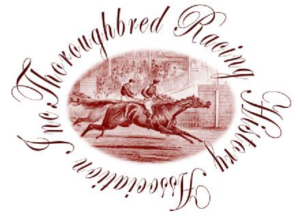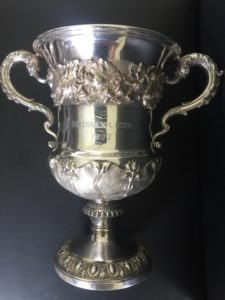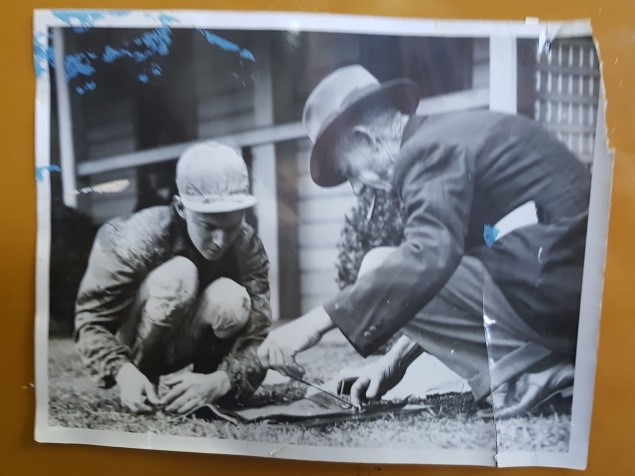Thoroughbred Racing History Association Inc. Summer Newsletter
Wednesday, 07 March 2018

Thoroughbred Racing History Association Inc. Summer Newsletter - From the President
The TRHA is planning two significant events in the first half of the year.
The first will be the opening of the Stanley Room, a dedicated display housing the collection of trophies, photographs and memorabilia associated with horses owned by Bill and Evelyn Stanley – two stalwarts of Queensland racing in the post-war era.
They raced no fewer than 99 horses including top liners Rajah Sahib, Cyron, Mr Cromwell, High Sail and among races they won were a Cox Plate, Stradbroke Handicap, Doncaster Handicap, Australian Cup and Queensland Derby. The Stanley Collection will illustrate the successes of the couple’s horses, from the early days when Mr Stanley owned and trained a small team from stables at Ipswich including one venture when he trucked three horses to Goondiwindi for a two-day meeting and won four races.
Mr Stanley had been an Australian champion sailor and a top rugby league footballer. He and Mrs Stanley established a successful plastics manufacturing business at New Farm and willingly helped out racing licensees down on their luck by giving them employment in their factory. Mr Stanley became a committeeman of the Queensland Turf Club. The Association with the support of the Brisbane Racing Club is putting the finishing touches on the Stanley Room. No date has been set for the opening.
Our second major event will be on May 1 when the Association again will take part in the Australian Heritage Festival with a presentation evening to present an historic perspective on the winter carnival. The event is in its planning stages but we hope to have replays, interviews and displays recalling the highlights of past winter carnivals. The venue will be the Winner’s Circle in the main Doomben Grandstand. The evening will be along the lines of the highly successful ‘Hot Favourites – The Voices of Racing’ presentation held during last year’s Heritage Festival. The Association’s function will be one of an estimated 1200 events being held as part of the Heritage Festival around Australia. The National Trust, host body for the festival, is encouraging organisations like us to tell our stories and we have elected to focus on the winter carnival which has become a centrepiece of Queensland’s racing culture. We will tell you more of the evening as we bed down the details of the presentation.
Hope to see you on May 1.
Peter Howard
When the Brisbane Cup was run in Sydney
At the Archive, we were intrigued by a phone call seeking information about the 1827 Brisbane Cup.
At first, we thought the caller meant the 1927 Brisbane Cup. "No", said the caller. 1827. But the first race meetings in the Brisbane area were not until the 1840s – firstly at Coopers Plains in 1843 and then New Farm in 1846. Racing did not start at Eagle Farm until 1865 and the first known Brisbane Cup was in 1866.
A Brisbane Cup in 1827? One of our volunteer researchers Alan Capper began combing through the newspaper files and discovered there was a Brisbane Cup in 1827 – but it was run in Sydney. The race was named the Brisbane Cup after the colony’s Governor Sir Thomas Brisbane who was patron of the Sydney Turf Club which held its first meeting in Hyde Park in 1825. A new racecourse was laid out the next year on the road to Parramatta about 6km west of Sydney, and Governor Brisbane donated a trophy for the main race. That was the first Brisbane Cup and was the first of six such Brisbane Cups run annually in Sydney.
Governor Brisbane’s term of office came to an end in 1826 and he returned to England, but he sent a trophy to the STC for the 1827 Brisbane Cup – and that’s the trophy that is now owned by a Brisbane family. The winner was Junius, who had also won the 1826 Cup and who was regarded as the best racehorse in the colony. How the Brisbane Cup ended up being owned by Queenslanders is a mystery, but it is believed it has been handed down through the generations of at least two families.

Out of the past . . . the 1827 Brisbane Cup.
S is for Stradbroke Handicap, Queensland’s premier race
By Mark Mazzaglia
The Stradbroke Handicap is Queensland’s flagship race and is the premier feature event run during the annual Queensland Winter Carnival.
The first running of the Stradbroke Handicap was in 1890 over six furlongs and was won by Pyrrhus while Suncup won the prestigious sprint the first time it was run over seven furlongs in 1953. Brisbane’s racing headquarters at Eagle Farm Racecourse is the spiritual home of the Stradbroke Handicap but because of extended track redevelopments the Stradbroke Handicap was run at Doomben in 2015 and 2017 and will be again this year with the distance being shortened to 1350m.
The Darren Beadman trained three year old Impending carried the famous Godolphin royal blue colours to victory in 2017 and collected a sweet $1 million for his win over In Her Time and Clearly Innocent. The Stradbroke Handicap is among the top echelon of sprint races on the Australian Racing Calendar and its prizemoney is comparable with the other Group 1 sprints around the nation.
Prizemoney levels have steadily risen throughout the years and today’s purse is a major boost to the $40,000 winner’s cheque 100-1 outsider Sir Wisp collected for trainer Tony Mazzaglia and his large group of owners with his upset win in 1977. [Editor’s note: Tony Mazzaglia was the writer’s father.] Sir Wisp shared the honour as the longest priced Stradbroke Handicap winner with the Tom Doyle trained 1960 winner Wallgar.
The distance for the Stradbroke Handicap was officially changed from seven furlongs to 1400m in 1972 when it was won by Triton while 1998 winner Toledo, with Brian York in the saddle, holds the race record of 1:20.2. The Barry Baldwin trained 2016 winner La Montagna was a memorable home town victory as was River Lad’s win in 2014 for Sunshine Coast trainer Natalie McCall and visiting jockey Damien Oliver.
The Stradbroke Handicap is regarded as one of the toughest Group 1 sprints to win but several high quality horses have managed to claim victory on two occasions. The Con Karakatsanis trained Black Piranha was the last dual winner of the Stradbroke and heads a decent line up of two time winners that include Rough Habit (1991, 1992), Daybreak Lover (1984, 1986), Lucky Ring (1949, 1950), Petrol Lager (1934, 1935), Highland (1925, 1926), Gold Tie (1918, 1919) and Babel (1895, 1896) while 1958 winner Wiggle was the last two-year-old to beat the older horses in the tough 1400m sprint.
Multiple Group 1 winning Kiwi galloper Rough Habit (pictured) deserves special mention and was a regular member of New Plymouth trainer John Wheeler’s Winter Carnival team that arrived in Queensland every winter. As well as winning the Stradbroke Handicap on two occasions, Rough Habit became a favourite with racegoers by winning the 1990 Group 1 Queensland Derby (2400m) as a three year old and three Group 1 Doomben Cups (2020m) in 1991, 1992 and 1993.

The Kiwi raider . . . Rough Habit won two Stradbrokes as well as the Queensland Derby and three Doomben Cups.
Book Review
The Australian Racing Annual 1961-62.
The Annual gives you details of major races including the 1960 Melbourne Cup of which there is a detailed account by journalist Rollo Roylance. Can you believe there were 32 starters?
The VRC handicapper had allotted Tulloch 10stone 1pound on a 6.10 minimum and such was Tulloch’s reputation that some experts declared he was thrown in. And remember Tulloch had been away from racing for almost two years until his comeback from illness early that year. Rivals included New Zealanders Ilumquh, Howsie, Ma Cherie and the bolter Hi Jinx who won at 50 to 1. The local stayers included Dhaulagiri ridden by Geoff Lane and White Hills whose jockey was Roy Higgins. While Tulloch had won the Cox Plate in record time he had to out-perform Comic Court who had won the Melbourne Cup with 9.5 after winning the Cox Plate. His trainer Tommy Smith was very confident.
More than 100,000 saw the race which was marred early when Dow Street ridden by Darby McCarthy fell. On settling, Tulloch (Neville Sellwood) was well back and with a half-mile to travel he was still 24th. At the two furlongs he was 10th and he finished seventh, beaten four lengths.
This book highlights many top races in detail. It also contains a tribute to the dominant sire Star Kingdom. Other sires of the era included Earldom, Good Brandy, Highstrung, Orgoglio, Persian Book and Syntax and the stallion who influenced Queensland racing most of all, Smokey Eyes.
Sellwood at the Creek – a rare photograph

This rare photograph of Neville Sellwood has been discovered by one of our volunteer archivists Paula Burnett while cataloguing images for the valuable pictorial collection in the library at Doomben.
It shows trainer W.Barton helping Sellwood pack his lead bag before riding Cash Man to win the main race at Albion Park on August 1, 1942. Sellwood was 20 at the time and on his way to becoming one of Australia’s great jockeys. He won two Melbourne Cups, an English Derby, a W.S. Cox Plate, four Victoria Derbies, two AJC Derbies and two Caulfield Cups.
Sellwood was born at Hamilton, not far from Eagle Farm racecourse. While based in Sydney, he returned to his home town frequently and won a Stradbroke Handicap on Grey Ghost, Quensland Derby on Travel Boy, Brisbane Cup on Cambridge, two Doomben Ten Thousands on El Khobar and In Love and two Doomben Cups on Tossing and Prince Delville. Sadly, he was fatally injured in a race fall in France in 1962.